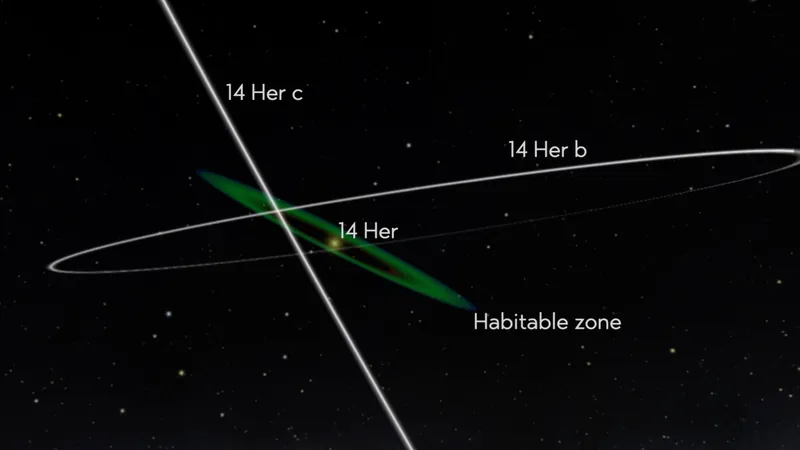
JWST Discovers Frigid Exoplanet with a Peculiar Orbit: A New Era of Astronomical Insight!
2025-06-14
Author: Emma
In a groundbreaking achievement, the James Webb Space Telescope (JWST) has captured a stunning direct image of a distant and icy exoplanet, unveiling a solar system that is anything but ordinary.
Meet 14 Herculis c: A Cold and Ancient World
Named 14 Herculis c (or 14 Her c), this planet resides about 60 light-years away in the constellation Hercules and orbits a sun-like star. Its JWST image reveals a dim orange dot, representing the radiant heat from its frigid atmosphere, which sits at a chilling 26 degrees Fahrenheit (minus 3 degrees Celsius)!
An Unusual Orbital Dance in the Cosmos
14 Her c orbits its star at an astonishing distance of roughly 1.4 billion miles—about 15 times farther than what we experience between Earth and the Sun! Intriguingly, if it were part of our solar system, it would position itself in the vast space between Saturn and Uranus.
However, the layout of the 14 Herculis system is wildly misaligned. The two known planets, including 14 Her c, weave around their star at angles of approximately 40 degrees to each other—forming an eye-catching "X" pattern. This odd configuration may have stemmed from a former third massive planet's ejection, leading to a gravitational tussle that forged this unique orbital arrangement.
A Scientific Breakthrough—Imaging the Improbable
For astronomers, imaging 14 Her c was no easy feat. With nearly 6,000 known exoplanets, very few have been directly imaged due to the challenge of distinguishing them from the blinding light of their host stars. According to Balmer, they are akin to "fireflies next to lighthouses." Typically, only hot and young gas giants shine brightly enough to be captured—cold, older planets like 14 Her c are usually far too dim.
Yet, thanks to its tilted orbit, the team was able to predict the JWST could successfully detect this elusive planet. Utilizing a specialized starlight-blocking feature called a coronagraph, they managed to extract 14 Her c's faint infrared glow.
A Surprising Discovery in the Planet's Atmosphere
Despite expectations of a brighter appearance based on its estimated age of 4 billion years and a mass seven times that of Jupiter, 14 Her c turned out to be much dimmer than predicted. Balmer provides insight: "We're not viewing a problem with evolutionary models but rather a fascinating aspect of this planet's configuration." The JWST also identified carbon dioxide and carbon monoxide in its atmosphere, suggesting dynamic updrafts are bringing hot gases from the depths to the cooler upper layers.
Expanding the Horizons of Exoplanet Studies
The discovery of 14 Her c signifies an expansion in the types of exoplanets astronomers can investigate. By observing planets with varying masses, temperatures, and orbital histories, scientists aim to unlock the mysteries surrounding the formation and evolution of planetary systems—including our own.
As Balmer emphasizes, understanding these worlds can shed light on our own cosmic journey. This is just the beginning of a new era in exoplanetary exploration!









 Brasil (PT)
Brasil (PT)
 Canada (EN)
Canada (EN)
 Chile (ES)
Chile (ES)
 Česko (CS)
Česko (CS)
 대한민국 (KO)
대한민국 (KO)
 España (ES)
España (ES)
 France (FR)
France (FR)
 Hong Kong (EN)
Hong Kong (EN)
 Italia (IT)
Italia (IT)
 日本 (JA)
日本 (JA)
 Magyarország (HU)
Magyarország (HU)
 Norge (NO)
Norge (NO)
 Polska (PL)
Polska (PL)
 Schweiz (DE)
Schweiz (DE)
 Singapore (EN)
Singapore (EN)
 Sverige (SV)
Sverige (SV)
 Suomi (FI)
Suomi (FI)
 Türkiye (TR)
Türkiye (TR)
 الإمارات العربية المتحدة (AR)
الإمارات العربية المتحدة (AR)